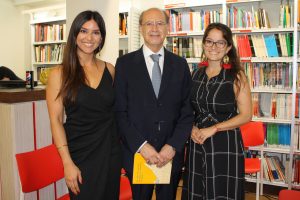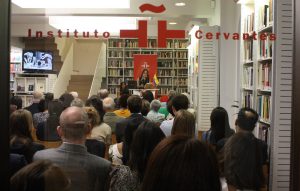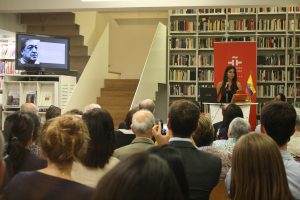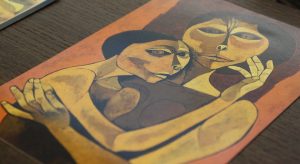Ecuador and Spain introduce Guayasamín in London as one of the great artists and witnesses of the 20th century
The Embassy of Ecuador and Instituto Cervantes celebrate, in London, the 100th anniversary of the birth of the great Ecuadorian painter and artist Oswaldo Guayasamín, with a conference by Goldsmith University art historian and artist Daniela Galán and the dance anthropologist, dancer and actress Estefanía Solórzano.
«As Ambassador of Ecuador in the United Kingdom, it is an honor to commemorate this month, at Instituto Cervantes in London, the centenary of the birth of the artist Oswaldo Guayasamin, a giant from Ecuador and America, whose work is known around the world, his plastic creations are moved by his aesthetic strength and the enduring message of eternal works,” explains Jaime Alberto Marchán Romero, Ambassador of Ecuador to the United Kingdom.
Marchán Romero emphasizes that the Ecuadorian master dominated all the expressions of art: canvas, mural composition, sculpture and prints. Romero added that, in the intellectual field, Guayasamín played a decisive role in the struggle for his ideals of social justice. “Through his brush, he spoke for the oppressed of the world. His cry was immense and still resonates, angry and haughty, in museums, walls and squares, but, above all, in the hearts of men,” he adds.

The Ambassador believes that this event at Instituto Cervantes has a special significance, as it is an opportunity to make the work of the great Ecuadorian artist better known in this cosmopolitan country. It also renews in Instituto Cervantes, “the deep ties that unite Latin American countries through language, culture and art, through which we have enriched each other.”
“Guayasamín is an artist who seems to summarize the greatness and contradictions of Latin America. Beyond its plastic power, so characteristic and so linked to the traditions of the subcontinent, all Latin American themes are in it. And I say Hispanic Americans because few artists have made such a good bridge between America and Spain. For us it is a joy to open the doors to Guayasamín and Ecuador on their national day, ”says the director of the Cervantes Institute in London, Ignacio Peyró.
In Ecuador, when Estefanía Solórzano began her theatre studies, she began to go to museums a lot and also approached Ecuadorian painting, dance and literature. It was at that time when she also rediscovered the work of Guayasamín and began to frequent the museum ‘La chapel of man’, in Quito, built by the artist in homage to the human being.

The most intimate expression of the human being
Guayasamín was always surrounded by many artist friends (painters, musicians, writers, etc.) and Solórzano was interested in knowing the history of that circle. “The focus on the eyes, hands and face always struck me. I see it as the way in which one gets to know another person through the eyes. Guayasamin offers us the most intimate expression of the human being in the eyes and hands, and that is where terror, love, tenderness and poetry are,” she explains.
Solórzano began her MA in Dance Anthropology two years ago, on an itinerary that took her to Norway, France, Hungary and finally to the United Kingdom last January. Currently, she develops a project based on memory and oblivion, for which she was inspired by one of Guayasamín’s works: “As long as I live forever, I remember you”, which belongs to the series ‘The age of tenderness’.
«The skin outside, the skin inside»
Solórzano identifies with Guayasamín and his idea of «The skin outside, the skin inside». In the first one, Guayasamín refers to his artistic work in the time he has lived; while, in the second term, he encompasses all the experiences of a child and what he lived with his family, facts that moved him all his life.
Guayasamín describes that he painted ‘The Age of Wrath’ as if he were screaming desperately, adding to all those screams that express the humiliation and anguish of the horror events experienced by Humanity in the twentieth century.
The construction of a world art scene
In the case of historian Daniela Galán, her talk revolves around the importance of the artist in the context of the history of Latin American art and its impact on the construction of the world art scene. Anger will be the starting point to examine how Guayasamín and other artists approach the indescribable, situations of pain, trauma and violence, without falling into sensationalism.
«In the paintings of Guayasamín you can see not only the pain of the victims, but also the frustration of living in certain historical moments and having lived so much pain, such as the Holocaust, the Spanish Civil War or the bombs of Hiroshima and Nagasaki», explains Galan, for whom Guayasamín is indispensable in the history of Latin American art. He also drew attention to the rights of the indigenous, with his mixture of indigenous and mestizo.




